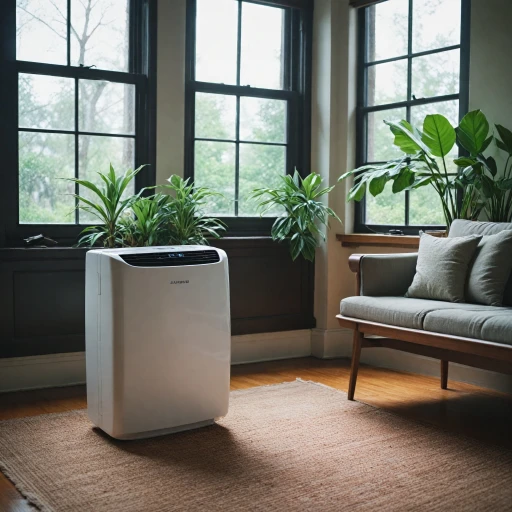Understanding Your RV's Cooling Needs
Assess Your RV's Cooling Requirements
Understanding your RV’s specific cooling needs is a crucial first step in the search for the best portable air conditioner. Not all spaces within an RV are created equal, and factors such as the size of your RV, its layout, and the average climate of your travel destinations can significantly influence the cooling capacity you require.
Many RV owners consider the square footage as a guideline for selecting a portable air conditioner. The cooling performance of a unit, often measured in BTUs (British Thermal Units), is a key indicator of how effectively it can cool your space. For instance, a small RV may need a 5,000 to 7,000 BTU air conditioner, whereas larger rigs might require units with 12,000 BTUs or more.
It's also essential to think about the external environment and how often you will be using your RV in hot conditions. If you're traveling through particularly hot areas, maximum efficiency might be a priority, which means considering models with higher BTUs or energy efficiency ratings.
Moreover, assess whether your RV setup is more suited to a fan or a heat pump integrated unit. Some may prefer units with dual hose functionality for better energy efficiency, while others might need a remote control for convenience. Portable air conditioners come in various forms, such as white or metallic colored casings, which can blend with your RV’s aesthetics.
If you're unsure about where to begin with these considerations, reading customer reviews can offer invaluable insights into the cooling performance and installation ease of different products.
Explore the benefits of different air conditioning solutions in RVs to gain a deeper understanding of what might suit your needs.
Key Features to Look for in a Portable AC Unit
Essential Features for Optimal Cooling
When choosing a portable air conditioner for your RV, it's crucial to consider various features to ensure maximum comfort and efficiency. The right portable AC unit can not only make your stay inside the RV more enjoyable but also maintain optimal temperature levels in different room settings.
- Cooling Capacity and BTU Rating: One of the most critical factors to look for is the unit's cooling capacity, often measured in BTUs (British Thermal Units). A higher BTU rating typically indicates that the unit can cool larger spaces more effectively. For RVs, a unit with a cooling capacity ranging from 5,000 to 15,000 BTUs is generally effective. You can find more details on BTUs in this exploration of the Frigidaire 15000 BTU air conditioner.
- Energy Efficiency: A high energy efficiency rating ensures that your portable air conditioner consumes less power, translating to lower energy bills and less strain on RV power sources. Look for units boasting energy-efficient designs and features, such as heat pump functions that also allow cooling and heating.
- Ducted and Dual Hose Options: Ducted or dual hose units often provide more efficient cooling by minimizing warm air infiltration into the RV. Consider an option that best suits your needs, whether you require optimal cooling performance or a universal air conditioning experience.
- Remote Control and Smart Technology: For ease of use, opt for a portable AC unit with a remote control, allowing you to adjust settings from afar. Some advanced products also come with smart technology compatibility for more convenient control through mobile devices.
- Customer and Product Reviews: Before making your purchase, look into customer reviews and product descriptions. Real user experiences can provide valuable insights into the air conditioner's performance, reliability, and overall satisfaction.
Being equipped with the right features, a portable air conditioner can vastly enhance your RV cooling needs, making your travels more enjoyable and comfortable.
Comparing Portable AC Units: Pros and Cons
Weighing the Options: Best Portable AC Units for Your RV
Exploring the market for portable air conditioners can be overwhelming given the extensive range of products available. When comparing units, it's crucial to consider several factors including cooling performance, energy efficiency, and customer reviews, all of which contribute to finding the best portable option for your RV.
First, look at the cooling capacity of the unit, typically measured in British Thermal Units (BTUs). The BTU rating is imperative as it determines how effectively the air conditioner can cool your RV. A higher BTU indicates a stronger cooling power, which can be beneficial if you have a larger RV or often park your camper in hotter climates.
Consider the Cooling System
Portable air conditioners come in various forms, primarily single hose and dual hose. While a single hose system is more affordable, a dual hose model offers better cooling efficiency by drawing and exhausting air through separate paths. This can prevent the compressor from overworking and maintain a more comfortable temperature inside your RV.
Reviews, Ratings, and Features
Customer reviews and ratings provide insight into the real-world performance of these air conditioners. Evaluating reviews can inform you about recurring issues, such as noise levels or energy consumption concerns. Check for features like remote control capability and universal air venting options to maximize convenience and efficiency on the road.
Certain units also come equipped with additional functionalities, such as a heat pump, which can be advantageous for winter RV trips. Products like those by Dometic, available on platforms like Amazon, have gathered favorable reviews for their durability and effective cooling and heating capabilities.
For comprehensive details on cooling systems and more, explore this
resource on AC roof units. By thoroughly vetting these aspects, you can ensure the portable AC unit you choose meets your needs for both comfort and efficiency.
Installation Tips for Portable AC Units in RVs
Setting Up Your Portable AC Unit in an RV
Installing a portable air conditioner in your RV requires a bit more consideration than simply plugging in the unit. You want to ensure optimal cooling performance while maintaining energy efficiency. Here are a few practical tips:
- Choose the Right Spot: Placement is key. Find a location where the unit can easily vent out hot air without obstruction. A spot near a window or vent is often ideal but avoid placing it where direct sunlight can reduce its efficiency.
- Ensure Proper Ventilation: Many portable air conditioners come with a hose to ventilate hot air. Ensure the hose is properly connected and the exhaust is not obstructed to keep your room cool and comfortable.
- Power Considerations: Before installation, check if your RV's power setup can support the air conditioner's power requirements. The BTU rating will help you determine this. Balance the cooling capacity with your RV's energy capabilities for the best portable cooling solution.
- Noise Factor: The fan and cooling units can generate noise. Position your portable conditioner where noise won't disrupt activities or rest periods. Reading through product descriptions and reviews on platforms like Amazon can give you an idea of what to expect in terms of noise levels.
- Portable Unit Support: Depending on your RV model, ensure the unit has a stable, flat surface for operation. Some units, especially those with higher BTU ratings or dual hose setups, may require more support due to size and weight.
With these considerations addressed, installation should be straightforward, enhancing your journey with cool, comfortable air.
Maintenance and Troubleshooting for Portable AC Units
Keeping Your Portable Air Conditioner in Top Shape
To ensure your portable air conditioner performs at its best, and to extend its lifespan, regular maintenance is essential. Following these steps can help maintain optimal cooling and efficiency in your RV.
Regular Cleaning
Dust and debris can build up inside the unit, diminishing its cooling performance and energy efficiency. Therefore, make it a habit to clean the air filter regularly, ideally every two weeks or as specified in the product description. Most portable air conditioners have washable or replaceable filters, so check the manufacturer’s instructions. Additionally, wipe down the fan, exterior, and other accessible parts with a damp cloth.
Check the Cooling Performance
Monitor the unit's cooling capacity and energy efficiency by keeping track of temperature discrepancies and power usage. If you notice your room isn't as cool comfortable as it should be, or the unit seems to be running longer than necessary, it might be time to service the unit or consult the conditioner customer service for troubleshooting.
Assess the Drainage System
Portable air conditioners need to remove the moisture generated during the cooling process. Regularly check the drainage system to ensure it is functioning correctly and the water is being disposed of properly, whether through a continuous drain or manually by emptying the water tank. Refer to the product description for detailed instructions.
Inspect for Wear and Tear
Routinely inspect the unit for any signs of wear and tear, particularly on the hoses, power cord, and remote control functionality. The universal air conditioner hoses, especially if dual hose models, are crucial for maintaining the unit's efficiency.
Maintain Thermostat and Controls
Ensure the thermostat and controls are working correctly. A malfunctioning remote control or thermostat can lead to inefficient cooling heating cycles. Keep user manuals handy for reference, and don’t hesitate to reach out to customer reviews or forums for troubleshooting advice if needed.
In conclusion, while portable air conditioners offer great convenience, they require regular maintenance to ensure top efficiency, especially during the peak summer months. By following these practical steps, you can enjoy a cool and comfortable environment in your RV while on the road. Remember, well-maintained units not only provide better cooling but also have a higher BTU rating efficiency and longer lifespan.
Maximizing Efficiency and Comfort on the Road
Enhancing Efficiency and Comfort During Your Journey
A portable air conditioner can significantly improve your RV's comfort levels if utilized effectively. Ensuring efficient air conditioning is key to maintaining a comfortable indoor temperature without overtaxing your unit or power supply. Here’s how you can maximize both efficiency and comfort on the road.
Start by considering the cooling capacity of your chosen unit. BTU ratings are critical as they determine how effectively your unit can cool the designated space. For RVs, selecting the best portable AC depends on the size of your interior. A model with a higher BTU rating, like a unit with 13,500 BTUs, is suitable for larger spaces but may consume more energy, so balance is crucial.
Investing in a unit with a heat pump function will add versatility, allowing for both cooling and heating depending on your needs. Reading customer reviews on platforms like Amazon can give insight into real-world cooling performance and energy efficiency of potential units.
Once installed, position the portable air conditioner strategically within the RV. Keeping the unit away from direct sunlight and ensuring the exhaust hose is as short as possible without kinks will improve air flow and overall efficiency. Utilize features such as remote control for ease of operation, and ensure you pay attention to product descriptions for details on cooling, energy efficiency, and noise level preferences.
Regular maintenance, as detailed previously, cannot be overstated. Clean filters regularly, and ensure the unit is in proper working order before each trip. Opt for dual hose designs if you're planning on staying in hotter climates as they generally offer better cooling efficiency.
Lastly, consider using additional tools like cooling fans, which can help move air around the space more effectively, creating a more uniformly cool room temperature. Ensuring white reflections on windows can also aid in preventing extra heat from entering your RV.
In conclusion, by understanding your unit’s cooling capacity and employing strategic operational techniques, you can effectively increase energy efficiency and comfort. This attention to detail not only optimizes air conditioning performance but also extends the life of your portable air conditioners.

